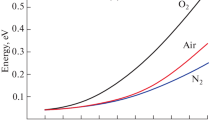Abstract—
Formation of hydrated electrons in water exposed to thermal electromagnetic radiation and influence of temperature (9–75°С) and D2O concentration (0–100 vol %) on their optical absorption spectra are investigated. Two distinct bands at 738 and 836 nm are observed in the initial spectrum. The spectra at temperatures from 10 to 80°С have two isosbestic points and four Gaussian components with domination of the component at 720 nm. As temperature rises, absorption increases and bands shift to the short-wave region. As the D2O concentration increases, the absorption spectrum intensity considerably decreases to its complete disappearance in 100% heavy-hydrogen water.



Similar content being viewed by others
REFERENCES
V. I. Bruskov, A. V. Chernikov, V. E. Ivanov, E. E. Karmanova, and S. V. Gudkov, “Formation of the reactive species of oxygen, nitrogen, and carbon dioxide in aqueous solutions under physical impacts,” Phys. Wave Phenom. 28 (2), 103–106 (2020). https://doi.org/10.3103/s1541308x2002003x
A. J. Swallow, “Hydrated electrons in seawater,” Nature. 222 (5191), 369–340 (1969). https://doi.org/10.1038/222369a0
N. Getoff, “Significance of solvated electrons \((e_{{{\text{aq}}}}^{ - })\) as promoters of life on earth,” In Vivo. 28 (1), 61–66 (2014). PMID 24425837
V. I. Bruskov, A. V. Chernikov, S. V. Gudkov, and Zh. K. Masalimov, “Heat-induced activation of reducing properties of sea-water anions,” Biofizika. 48 (6), 1022–1029 (2003) [in Russian]. PMID 14714518
N. F. Bunkin, N. V. Suyazov, A. V. Shkirin, P. S. Ignatiev, and K. V. Indukaev, “Nanoscale structure of dissolved air bubbles in water as studied by measuring the elements of the scattering matrix,” J. Chem. Phys. 130, 134308 (2009). https://doi.org/10.1063/1.3095476
K. Siefermann, Y. Liu, E. Lugovoy, O. Link, M. Faubel, U. Buck, B. Winter, and B. Abel, “Binding energies, lifetimes and implications of bulk and interface solvated electrons in water,” Nat. Chem. 2, 274–279 (2010). https://doi.org/10.1038/nchem.580
F. Daniels and R. A. Alberty, Physical Chemistry (Wiley, New York, 1966).
S. V. Gudkov, V. I. Bruskov, M. E. Astashev, A. V. Chernikov, L. S. Yaguzhinsky, and S. D. Zakharov, “Oxygen-dependent auto-oscillations of water luminescence triggered by the 1264 nm radiation,” J. Phys. Chem. B. 115 (23), 7693–7698 (2011). https://doi.org/10.1021/jp2023154
V. H. Arakeri, “Sonoluminescence and bubble fusion,” Curr. Sci. 85 (7), 911–916 (2003). http://www.jstor.org/ stable/24108772
V. S. Langford, A. J. McKinley, and T. I. Quickenden, “Temperature dependence of the visible-near infrared absorption spectrum of liquid water,” J. Phys. Chem. A. 105, 8916–8921 (2001). https://doi.org/10.1021/jp010093m
I. I. Zakharov, “Quantum chemical DFT calculations of the local structure of the hydrated electron and dielectron,” J. Struct. Chem. 55 (4), 631–640 (2014). https://doi.org/10.1134/S0022476614040027
Author information
Authors and Affiliations
Corresponding author
Additional information
Translated by M. Potapov
About this article
Cite this article
Bruskov, V.I., Karmanova, E.E., Chernikov, A.V. et al. Formation of Hydrated Electrons in Water under Thermal Electromagnetic Exposure. Phys. Wave Phen. 29, 94–97 (2021). https://doi.org/10.3103/S1541308X21020059
Received:
Revised:
Accepted:
Published:
Issue Date:
DOI: https://doi.org/10.3103/S1541308X21020059



